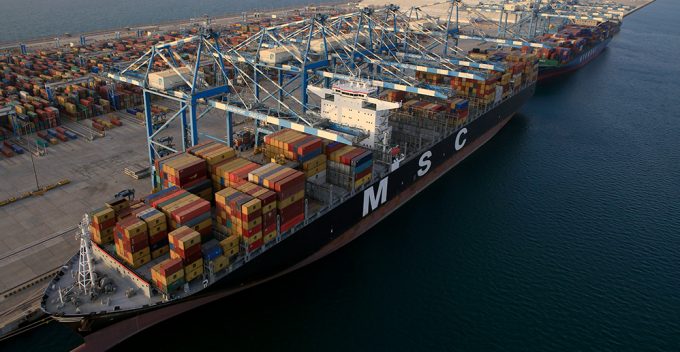MSC Aries now bound for Iran, and crisis will be 'a catalyst for higher rates'
Less than 2% of the containerships active in the Persian Gulf are Israeli-owned, and redeploying ...

The Middle East container terminal transhipment market is set to become more competitive after Abu Dhabi announced this week that its container handling capacity would jump by 50%.
The emirate’s port authority inveiled a $600m development in its South Quay area and Khalifa Port Logistics, as well as $435m expansion at Abu Dhabi Terminals (ADT).
The expansion at ADT will see the quay extended from 1,400 metres to 2,265 metres and the addition of 10 new ship-to-shore quay cranes — effectively doubling handling capacity from 2.5m teu to 5m teu.
The investment will also include significant technological advancements, such as fully automated truck loading and discharge.
Overall, Abu Dhabi will see its container handling capacity grow from 5m teu to 7.5m teu – although ultimately it is aiming to offer 9m teu capacity within the next five years.
The South Quay development is scheduled to be completed by Q1 21, including a 3km quay with 18.5 metres draught for general cargo, ro-ro and bulk usage. It will have eight berths and 1.3 million sq metres of yard.
Meanwhile, the Khalifa Logistics expansion, for multipurpose use, will encompass a 3.1km quay wall with a draught of eight metres, 15 berths and land plots, which can be tailored to individual customers.
The announcement builds on the strategy of Abu Dhabi billing itself as an alternative transhipment hub to nearby Dubai, with the port authority signing terminal deals with Cosco and MSC in recent times and the Cosco-managed CSP Abu Dhabi Terminal shifting from its trial phase to being commercially fully operational.
The deepwater, semi-automated container terminal includes the largest container freight station in the Middle East, and positions Abu Dhabi as the regional base for COSCO’s global network of 37 ports.
Naser Al Busaeedi, deputy chief executive of CSP Abu Dhabi Terminal, said: “COSCO continues to view Abu Dhabi as a logistics and trade hub of tremendous strategic global importance, as its location bridging east and west, combined with its commitment to excellence in infrastructure development, make it an international port of significance and an important point along BRI in the region. We look forward to the complete optimisation of the CSP terminal, raising cargo volumes to new highs and bolstering trade between markets far and wide.”
Capt Mohamed Juma Al Shamisi, group chief executive of Abu Dhabi Ports, said: “As global trade volumes increase over time, the world’s leading port operators must think decades ahead in their planning and execution.
“Through strategic collaboration with partners and top industry players, such as ADT, MSC, China’s CSP, and Autoterminal Barcelona, Khalifa Port is developing in a sustainable manner and has become one of the fastest-growing ports in the world. It continues to expand and innovate to meet the diverse needs of our business partners, while driving forward the UAE’s economy and its strategic partnership with China, its largest non-oil trading partner.
Ahmed Al Mutawa, chief executive of ADT, said: “The latest investment, which doubles our handling capacity to 5m teu by 2020, will see ADT take its place among the top 40 largest container terminals in the world, and positions us well for future growth.”
Comment on this article